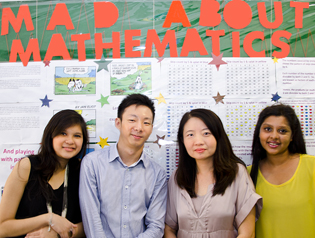Same Problem, Different Approach
Primary 4 pupils from Mee Toh School take five whole lessons to solve a couple of non-routine Math word problems. It’s not because they don’t know how to. In fact, the Math teachers had specially planned the lessons to be this way. Find out how they went about developing these lessons.
When asked if they were “ready for the challenge”, a class of Primary 4 pupils burst out in cheers: “Yeah!” This is something which rarely happens in a typical Math class. The enthusiasm and excitement to learn Math is a result of the work by four passionate teachers who identified the learning patterns of their pupils during Math lessons.
Taking Time to Understand
“Our pupils often encounter difficulties while solving non-routine word problems,” says Mrs Leong Seek Eng, the Head of Department for Math.

The teachers realized that teaching pupils to use Polya’s four-step method of understanding, planning, solving and checking wasn’t sufficient. Pupils were not focusing on the first two steps well enough to help them solve the non-routine problems with greater success.
As these pupils do not invest enough time on understanding the question and planning the solution, they tend to be less systematic when approaching a question. When they fail to find the solution and are stuck in a rut, it affects their self-confidence.
So Seek Eng, together with Math teachers Mdm Amalina and Mrs Mohana Parthiben and Research Activist Mr Darren Yeo, embarked on a project to get pupils in the habit of understanding a problem first before planning the solution.
Tackling Problems Properly
Rather than dictating that the pupils read and understand the question before attempting to answer it, the team decided to try a different approach.
They adopted the STARtUP tool, which stands for “START Understanding and Planning”. STARtUP consists of five components – Given, Find, Picture, Topic(s) and Heuristic(s). The aim of this framework is to remind pupils not to rush into solving a problem without going through the steps of understanding and planning.
“Each session, we cover one component,” shares Amalina. “For example, Given will be covered in one session. The next session, we cover Find.”
This approach was adapted from Dr Lee Ngan Hoe’s Problem Wheel. Dr Lee is an Assistant Professor with the Mathematics and Mathematics Education Academic Group in NIE. (Find out more about Dr Lee’s Problem Wheel in “Teaching This Thing Called Metacognition“, SingTeach, Issue 20.)
Originally designed for secondary students, the team of teachers at Mee Toh modified it for their younger learners.
“This project focuses on non-routine problems,” Darren says. “These are challenging problems that pupils often struggle with.”
Problem Solving with Confidence
One important factor to making lessons successful is by asking pupils questions that will stimulate their thoughts. To guide pupils in planning the solution to a problem, the scaffolding questions are carefully planned.
“I think it is more on questioning techniques,” says Mohana, a Learning Support teacher for Math. “That’s why we include this when we plan – what kind of questions we want the teachers to ask.”
– Mrs Leong Seek Eng, Mee Toh School
This method of tackling a problem sum ensures that pupils understand the question enough to solve it at the end of five lessons. A single lesson lasts an hour. Although it does take more time, pupils learn how to properly approach a Math problem, and with this understanding, their attention span improves.
With STARtUP, pupils will learn to be independent learners and not be afraid of making mistakes. It helps them overcome their habits of erasing their written work when their answer is different from their classmates.
“They should identify what has gone wrong and correct their own solutions,” Amalina says. “This helps to build their confidence in problem solving.”
Sharpening Teaching Skills
The team went through a few stages of planning and development before implementing the framework in a Primary 4 class last year. This year, the team has made additional improvements to the framework.

Through in-house training sessions, the teachers sharpen their skills in setting level – appropriate questions for their pupils. They are also able to set questions for pupils of different abilities to ensure a richer learning experience.
It took the team many sessions of brainstorming to develop a curriculum that would best meet the needs of their pupils. As part of the teachers’ professional development, they are also required to meet weekly and exchange ideas and experiences.
“There is a lot of development going on when we discuss our teaching,” Seek Eng adds. “We hear how other teachers go about teaching Heuristics effectively.”
Although a lot of hard work goes into the planning of such a curriculum, it all pays off when they see pupils who were once uninterested in Math now so alive in class when solving problem sums. As Mohana puts it: “We were so impressed!”






